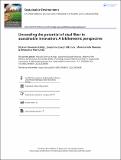| dc.description.abstract | Sisal fiber has increasingly attracted attention as a sustainable bio-based material due to its biodegradability, availability, and relevance to circular economy initiatives. Given its underutilization in high-impact applications and the limited integration of East African contributions, there is a growing need to assess the global research dynamics surrounding sisal fiber. This study hypothesizes that a bibliometric approach can reveal critical patterns, emerging themes, and collaboration gaps in sisal fiber research over the past decade. Using 59 curated articles from the Dimensions database (2012–2024), the study employed VOSviewer and Excel to analyze thematic evolution, citation patterns, and co-authorship networks. Findings show a rapid growth in publications from 2021 to 2024 (67.8%), led by Brazil and India, with emerging focus areas including waste valorization, biocomposites, and LCA-based sustainability assessments. The study concludes that targeted research investment, policy support, and international collaboration are essential to enhancing sisal fiber’s role in global sustainability transitions. | en_US |

